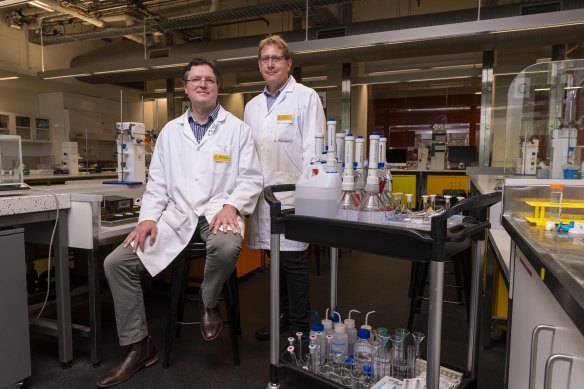- Exclusive
- Environment
- Sustainability
- Pollution
Cooking oil, poo and drugs: Mystery of grime balls on Sydney beaches solved
It’s the mystery that gripped Sydney for weeks – and now science has solved it, even if the answer is unpleasant.
The thousands of mysterious black balls that were washed up on beaches a few weeks ago have been revealed to be a mix of cooking oil, soap scum, faeces, medication and recreational drugs, and plastics.
University of NSW Associate Professor Jon Beves, a chemistry expert, said he and his colleagues had tested samples of the balls that were washed up on Coogee Beach – and the results were much more disgusting than he expected.
“I always expected them to be like crude oil, and if you smell kerosene or … even heavy oil, it doesn’t smell that bad,” Beves said. “But this really smells disgusting. It smells much more like what you’d expect in a sewer. They really are gross.”
Beves said the results of the extensive testing at UNSW disproved the original theory the lumps that landed at Coogee, Bondi, Tamarama and other eastern suburbs beaches were debris combined with oil from a maritime spill or seepage from a ship.

UNSW scientists have solved the mystery of the black balls found on Sydney’s beaches.Credit: Rhett Wyman
Carbon dating revealed mostly “modern carbon” – derived from plants and animals rather than fossil sources. This meant the term “tar ball” was not technically correct. Instead, it was more accurate to call them “fatbergs” or “FOG (fat, oil, grease) aggregates”.
The composition of the balls varied but about 17 per cent was fossil carbon, consistent with diesel fuel, and about 39 per cent was modern carbon, such as cooking oil and soap scum. The other elements were hydrogen and oxygen.
The modern carbon included traces of hundreds of chemicals, including a marker for human faeces, medications for high blood pressure and birth control, steroids, methamphetamines (ice), and THC (the active ingredient in cannabis).
Professor Alexander Donald, an analytical chemist at UNSW, said it was well established that recreational drug use showed up in testing of sewage.
“We looked for cocaine and heroin, too, but because they’re more water-soluble, if the balls were floating in the water, they would have been diffused,” Donald said.

Associate Professor Jon Beves and Professor Alexander Donald in the lab.Credit: Rhett Wyman
The testing also revealed PFAS, a family of plastics often known as “forever chemicals”, but the scientists said it was not the most common types that had been the focus of drinking water safety in recent months. Instead, there was a PFAS chemical used in waterproof clothing and an unusual PFAS chain that could be partially broken down.
A spokesperson for the NSW Environment Protection Authority said the presence of PFAS was “not unexpected due its ubiquity in our environment and … it did not necessarily mean there was a risk to human health”.
UNSW did its own testing when the balls were first washed up on Coogee using samples provided by Randwick City Council. It later became a collaboration with government agencies, including the EPA and the NSW Department of Climate Change, Energy, the Environment and Water.
The EPA said in a statement it had considered several possible causes, such as a shipping spill or wastewater outflow. Given the hundreds to thousands of different materials, it was probably from a source that released mixed waste, but it was unable to confirm the exact origin.
The EPA was awaiting further testing that would reveal more information about the types of oils.
NSW Maritime closely examined the weather patterns in the days before the event, but its analysis was inconclusive.
UNSW oceanographer Professor Matthew England said the ingredients in the balls could only have come from the sewerage system.
“The oiliness of the balls is what makes them float,” England said. “When they first form, they are irregular in shape, like a sort of flat pancake, but over time, the action of winds and waves knocks off the edges and rounds them out.”
Sydney has three deep ocean outfalls — at Malabar, Bondi and North Head — that discharge wastewater three kilometres off the coast and 60 to 80 metres below the surface. The sewage receives primary treatment including processes to remove solids and fats, oils and grease.
A Sydney Water spokesperson said there had been no issues with the normal operations of the Bondi or Malabar wastewater treatment plants, and it complied with its licences set by the EPA.
“Sydney Water acknowledges the tar balls may have absorbed wastewater discharge, which was already present in the water while forming, however, they did not form as a result of our wastewater discharges,” the spokesperson said.
Start the day with a summary of the day’s most important and interesting stories, analysis and insights. Sign up for our Morning Edition newsletter.